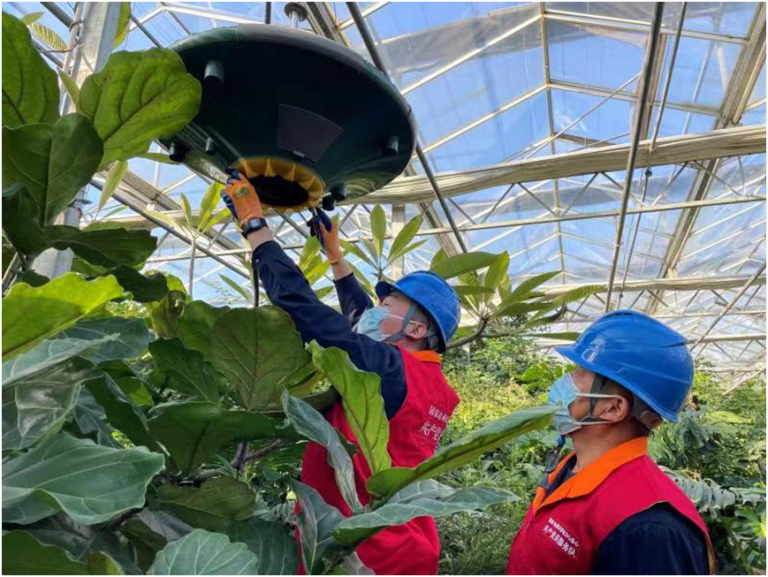
By Qiu Haifeng, Zhao Tingting, People’s Daily
“These ‘low-carbon’ cherry tomatoes sell well and taste nice,” said Sun Liming, a resident of Xiaoxinmatou village, Baodi district, north China’s Tianjin municipality, while handing a plate of scrambled eggs and tomatoes to his parents.
The “low-carbon” tomatoes Sun talked about from smart greenhouses of a local company engaged in the production and sale of agricultural and sideline products.
“We have grown vegetables for decades, and never thought that vegetables can be related to ‘low-carbon’ one day. A few years ago, electrical devices were introduced to all the greenhouses in our village, and we thought that’s the most advanced technological products we would ever use to grow vegetables. As it turns out, we were wrong. We have even better ones now,” said Wang Yishun, who is in charge of the smart greenhouses of the company.
The “better ones” mentioned by Wang are actually the equipment and devices installed by the State Grid Tianjin Electric Power Company’s branch in Baodi district for local greenhouses in a bid to save energy and reduce carbon emissions through intelligent transformation.
The smart nitrogen fixation devices installed in the greenhouses can ionize nitrogen and oxygen in air through artificial simulation of the process of nitrogen fixation during natural lightning activities, and dissolve them in water to directly create nitrate nitrogen that crops need. Besides, the soil-based solar energy storage system can effectively increase the earth temperature in the greenhouses, thus enabling efficient production throughout the year.
“For instance, if we grow one more crop of cucumbers and tomatoes every winter, their annual output can be increased by around 20 percent. In addition, the solar energy storage system has cut our costs significantly,” Wang added.
Wang introduced to People’s Daily the secret weapon for reducing carbon emissions in the production of vegetables: a small device that looks like a double door refrigerator in the corner of the greenhouses.
“The production and transportation of nitrogen fertilizers can produce a great amount of carbon dioxide. Now that we have this device, we buy more than 60 percent less nitrogen fertilizers for each mu (about 666.67 square meters) of tomatoes, for instance, than before. The device not only reduces our production costs, but is helpful in cutting carbon emissions,” Wang told People’s Daily.
According to Wang, the company lately designed a special label to distinguish its “low-carbon” vegetables from the other agricultural products in the market. By scanning the QR code on the label, consumers can get clear information about how the production of these vegetables achieved carbon emission reduction.

As greenhouse vegetable growers have made continuous progress in reducing carbon emissions, increasing output, and launching a traceability system to reassure consumers about the quality of their products, their “low-carbon” vegetables have gradually become popular choices in the local market.
So far, the State Grid Tianjin Electric Power Company’s branch in Baodi district has installed eight sets of nitrogen fixation devices for local greenhouse vegetable growers, helping realize low-carbon production of vegetables in greenhouses covering an area of 5,500 square meters.
Moreover, the company also provides customized smart agricultural equipment for local vegetable producers according to their needs.
Many innovative equipment and devices introduced for intelligent transformation, such as ultrasonic algae removal device, intelligent multispectral insect killer lamp, and water-saving micro-jet irrigation device, have helped local greenhouse vegetable producing companies save energy, increase efficiency, and realize eco-friendly production.
Although a lot of new devices have been added to their greenhouses, the electrical loads and power consumption of these companies haven’t risen much. The benefits they have reaped from the intelligent transformation are far more valuable than their input into the endeavor.
Vegetable greenhouses in Xiaoxinmatou village, which relied on manual labor for irrigation, are now watered automatically and on time by an automated irrigation system. Featuring low energy consumption, the new irrigation system has truly realized the purpose of saving energy and improving efficiency in production.
The ultrasonic algae removal device, which can effectively remove green algae from water, reduces the cost of manual work required for clearing green algae in water while helping improve the environment of the industrial park where local vegetable greenhouses are located.
As facts have shown, intelligent transformation has not only enabled greenhouse vegetable producing companies in Baodi district to maintain good control over costs and increase profits, but helped them reduce the use of fertilizers and pesticides and generate good results for environmental protection and social benefits.










